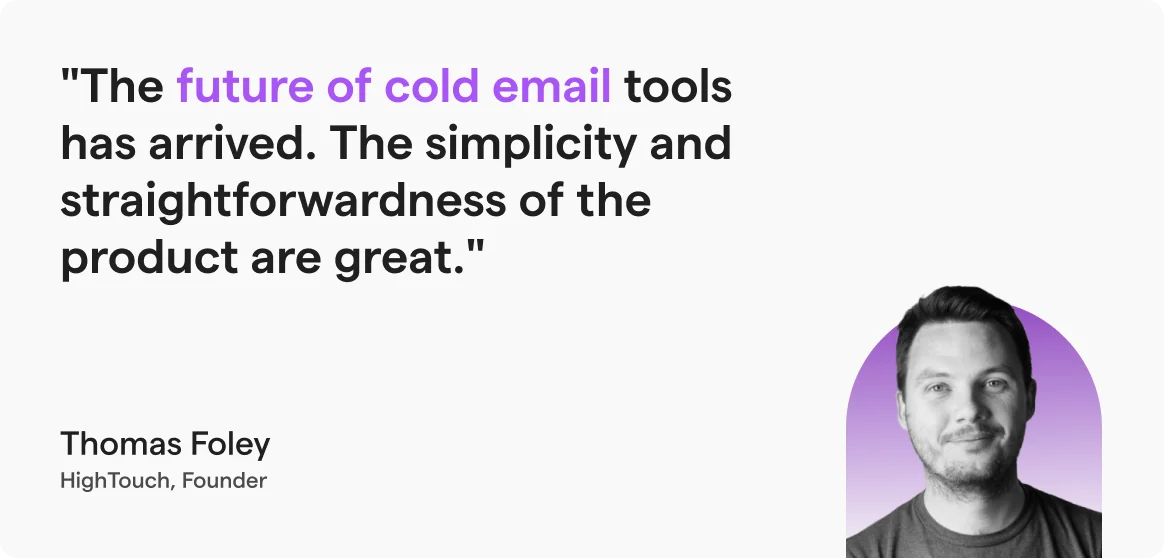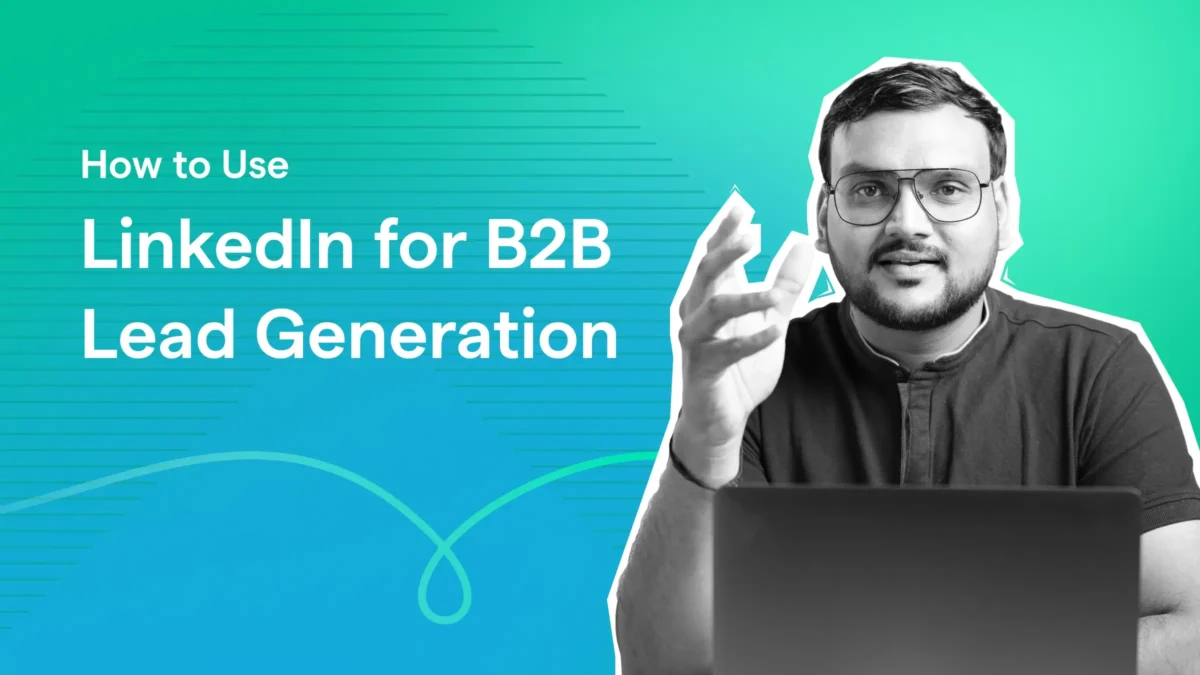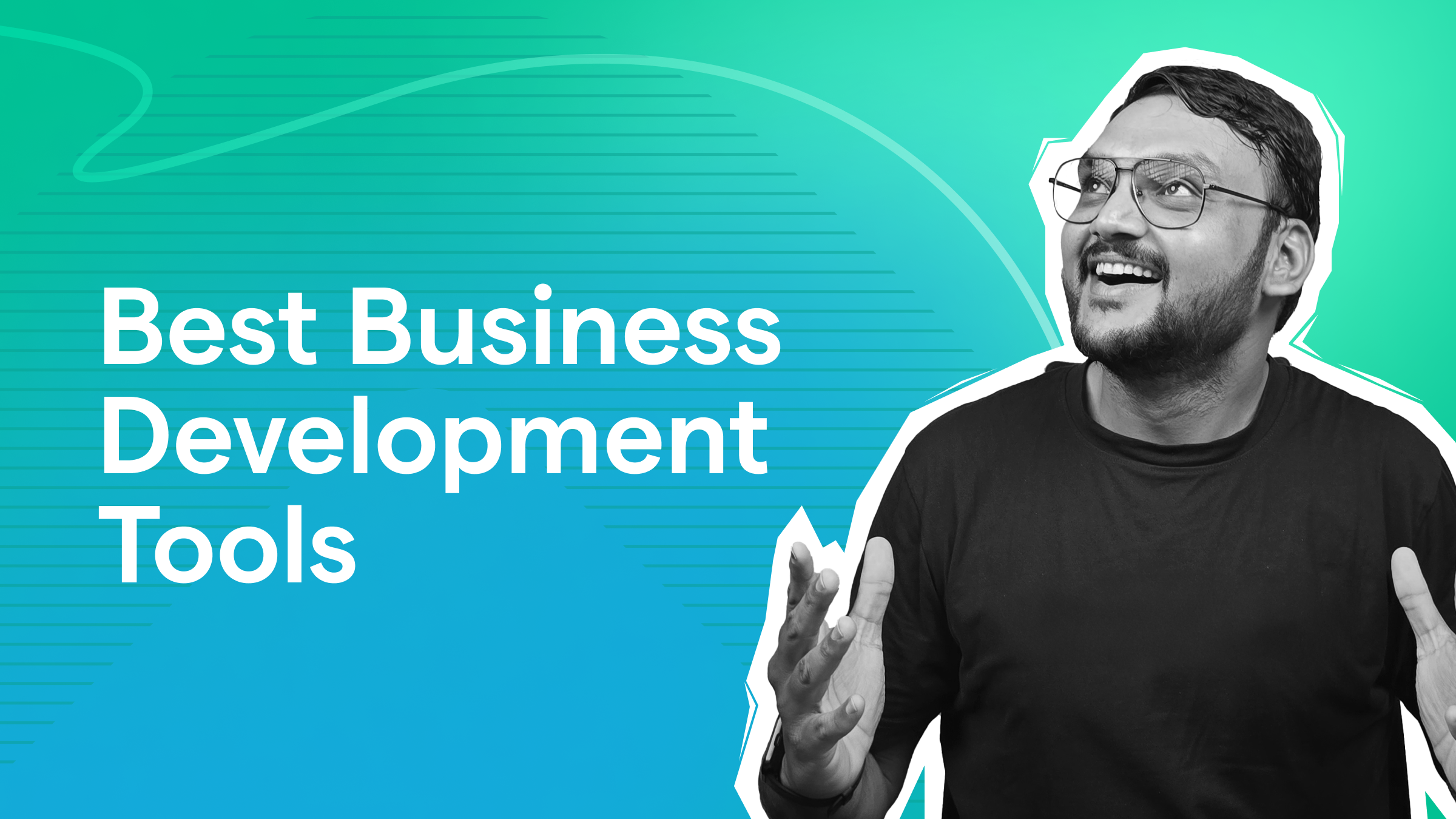Contents
- 1 LinkedIn B2B Lead Generation: Table of Contents
- 2 Why LinkedIn is Best for B2B Lead Generation
- 3 6 Proven LinkedIn Lead Gen Strategies (That Actually Work in 2025)
- 3.1 1. Send Cold Messages on LinkedIn
- 3.2 2. Use Social Selling to Build Trust and Attract Warm B2B Leads
- 3.3 3. Run Targeted LinkedIn Ads to Reach Decision-Makers at Scale
- 3.4 4. Host Webinars & Events to Attract High-Intent Leads
- 3.5 5. Join Groups & Communities on LinkedIn To Find Leads Similar to your ICP
- 3.6 6. Carry out a Multichannel Strategy To Bring the Best Results
- 4 What is the Best Way to do LinkedIn B2B Lead Generation
- 5 LinkedIn B2B Lead Generation: FAQs
I’ll be very honest here; you’re not the first one trying to generate leads from LinkedIn.
Thousands of B2B marketers, founders, and sales folks are already in the game. They have been testing with hooks, writing posts, sending DMs, running ads, and many more.
Some are crushing it, while most are still… in the guessing stage.
If you’re stuck in the guessing zone, that’s probably because:
- You’re using outdated tactics (like cold pitches with no context)
- You’re chasing quantity over quality
- Or worse, you’re just not showing up where your buyers are actually paying attention
But here’s the truth: LinkedIn still works, and it works damn well for B2B. You just need a better playbook.
In this guide, I’m handing you 6 proven LinkedIn strategies that I and many other experts in the industry use to book meetings, warm up high-ticket leads, and build authority.
If you’re serious about turning LinkedIn into your #1 lead gen channel this year, here’s the framework.
LinkedIn B2B Lead Generation: Table of Contents
Why LinkedIn is Best for B2B Lead Generation
Well, LinkedIn has 1 Billion+ professionals as users. And it’s very likely that your ICPs are there, waiting for you to reach out.
But there’s more to it than just numbers. And here’s why:
- Live & accurate data: Unlike static email lists or outdated CRM records, LinkedIn profiles are updated by users themselves. This means that the data stays fresh naturally.
- Powerful targeting: As long as you have a clear buyer persona of your prospects, it’s very easy to narrow down on your prospects.
- Built-in trust: By adding information about yourself to your profile and staying active on the platform, you can build trust and credibility.
That’s not all! Just by watching someone’s activity, you can understand their intent and time your outreach perfectly.
Here’s what to look for:
For Individuals
- Job changes – Open to new tools, partners, or services
- Posts & comments – Know their thoughts and even their requirements.
- Profile updates – Clues into new responsibilities or focus areas
For Companies
- Hiring announcements – The Team is scaling and might need new tools or vendors
- Funding news – Budget and expansion plans incoming
- Company posts – See what they’re promoting or prioritizing
- Leadership changes – Great time to engage new decision-makers
- Trend engagement – Spot shifts in focus or new strategic bets
If you make sure to stay updated on your prospects, you will be able to stay on the edge and make the right proposal at the right time.
6 Proven LinkedIn Lead Gen Strategies (That Actually Work in 2025)
There’s only one cheat code to winning on LinkedIn: earn trust.
And for that, your approach should be relevant, personalized, and well-timed.
However, figuring out what way suits you takes a lot of time and resources.
Let me save you from all of those hurdles.
Here are 6 effective LinkedIn strategies and the right tools that I use to find and convert high-quality b2b leads:
Pro Tip: Make sure you’ve already defined your ICP and prepared a lead list.
These strategies only work when you’re reaching the right people.
1. Send Cold Messages on LinkedIn
Best for: Sales reps, SDR, and founders.
In this, you are sending a message to someone for the first time on LinkedIn.
However, 76% of messages sent are ignored!
Because most go with generic and templated messages, leading to them being ignored.
But it can be easily fixed by personalizing your messages.
Let me show you the process…
How to Use Cold Messages for B2B Lead Generation
To write a personalized message that gets a reply, look at their activities.
Let me show you an example.
A person recently changed his job.
And now, when you are sending him a message for the first time, you can start by congratulating them.
That pinch of a personalized message will most likely get a reply.
And from there, you can take the conversation ahead.
Apart from that, you can use mutual interests, connections, or any posts they have shared on the platform.
Trust me, a touch of personalization will help a lot in getting your message noticed.
Now, how many messages are you planning to send every day?
You can maybe send 5 or even 10 messages a day. But if you want to scale?
That will be a problem, because LinkedIn doesn’t allow bulk messaging even with tools.
Even with Sales Navigator, the features are limited, and it comes with a hefty price.
That’s why I would suggest trying cold emailing.
Why Should You Try Cold Emailing?
With cold emailing, you will be able to:
- Reach more prospects at scale.
- Get insights about your campaign.
- Do proper follow-ups.
But there’s a problem: LinkedIn doesn’t give you the contact details of the prospects.
For this, I suggest going with a LinkedIn email finder extension like Saleshandy Connect As you will be able to:
- Instantly extract verified email addresses from LinkedIn profiles
- Save them and push them directly into your cold email sequence.
- And even offers integration with multiple tech stacks to improve your workflow.
So, I would suggest going with a LinkedIn message for initial contact,
And cold emails for follow-ups and those with whom you get to connect.
2. Use Social Selling to Build Trust and Attract Warm B2B Leads
Best for: Founders, consultants, and creators.
The current market trends are more aligned with trusting an individual more than the brand.
When you stay active by posting value-oriented content consistently and interacting with the posts on the platform, you will be able to build a strong personal brand.
A personal brand is very important for social selling.
It helps in building your brand as well as attracting prospects for your offerings.
Let me show you how it works:
How to Use Social Selling for B2B Lead Generation
To make social selling work, you need to be active and consistent on the platform.
That way, you will be at the top of your prospects’ feeds.
Here are the 3 non-negotiable things you need to do in social selling:
- Comment on posts from your ICP by sharing your thoughts and insights
- Make posts and video content by sharing case studies, industry news & how-tos, behind-the-scenes, or even helpful tips.
- You can even post memes and light humor.
Note: Don’t repost content from others. Always make sure to give your take on it or anything new that offers value to the users. This will make a good impression and help you build trust with your audience.
Also, keep in mind that staying active on LinkedIn will take effort.
You can use the help of these tools to make the process easier:
- Taplio: For content scheduling, repurposing, and analytics.
- LeadDelta: To organize and engage with your LinkedIn network like a CRM.
- Canva: For designing your posts.
If done right, you will get more replies to your DMs, leads will join your funnel, and even reach out themselves!
3. Run Targeted LinkedIn Ads to Reach Decision-Makers at Scale
Best for: Product launches, SaaS, webinars, and demand generation.
Ads make it easy to deliver your message to the right target audience.
Although it is expensive, you can generate a substantial number of leads using this channel when done correctly.
How to Use LinkedIn Ads to Generate B2B Leads From LinkedIn?
In order to get the best results, you need to understand the different ad types from LinkedIn.
You can use each of them to target a different set of audiences.
Here’s how to get started:
1. Choose the Right LinkedIn Ad Format based on your goals:
- Sponsored Content: These are normal ads that appear on the feeds.
- Lead Gen Forms: Ads with built-in forms that make it easy to capture lead data.
- Message Ads (InMail): Personalized messages sent directly to a user’s LinkedIn inbox using LinkedIn Sales Navigator.
- Carousel Ads: These are an extended version of the sponsored ads, where you can add multiple slides.
- Text and Dynamic Ads: Simple sidebar ads or personalized ads that use profile data to grab attention.
2. Target Your Ideal Audience: When setting up your target audience, make sure to go with the right filters like Job title, Company name, size, industry, skills, locations, and many more.
3. Craft Compelling Ad Copy and Creative: Offer a strong value with a clear call-to-action (CTA). You can even use high-quality images or videos to stand out in the feed.
However, before you start investing your resources, I highly recommend starting slow.
You can also take the help of LinkedIn Campaign Manager to get detailed performance reports of your ads.
This will help you to understand what works and level the issues in your campaigns.
You can always scale the campaigns that bring in good ROI.
4. Host Webinars & Events to Attract High-Intent Leads
Best for: Agencies, B2B SaaS, and service-led businesses.
Events and webinars are some of the best ways to attract leads with high intent.
You can even use these events to meet your leads and showcase your product or services
How to Use Webinars and Events to Attract High-Intent Leads
- Create an event with a clear benefit or takeaway in the title
- Promote it using your personal profile and company page
- DM attendees before the event to thank them and ask about what they hope to learn
- Follow up after the event via email (or LinkedIn) with slides, recordings, or a CTA
For this, I would recommend tools like:
- LinkedIn Events: For event setup and organic reach
- Zoom / Livestorm: For hosting webinars professionally
- Saleshandy: To follow up with attendees via cold or warm email
- Calendly: To schedule meetings post-event with qualified leads
If you want high-intent leads who are actively researching your space, webinars and events can be one of your most powerful lead-gen assets.
5. Join Groups & Communities on LinkedIn To Find Leads Similar to your ICP
Best for: Consultants, service providers, and B2B SaaS companies.
LinkedIn groups and communities make it easy to find high-intent leads based on your Ideal Customer Profile (ICP).
Joining these groups makes it easy to interact with your prospects.
You will be able to know their thoughts about the industry, interests, or even pain points.
How to Use LinkedIn Groups for Effective Lead Generation
Once you know your ICP, try joining communities where they are active. After that, you need to do somethings. Like:
1. Engage and Establish Authority: Be active by offering value. You can interact with posts and share your own insights on industry changes. This will help to build trust, and you can use the pain points to improve your solution. Also, look for members who consistently ask questions that align with your solution; these are your prospects.
2. Address Your Prospects: Pitch to your prospects at the right moment. Like, if a member responds positively to your advice or asks a specific follow-up question, use it to send them a personalized connection request or a direct message. In your conversation, reference their comment and offer a more tailored resource to gain their trust.
And the final step in successful group lead generation is getting the prospect into your funnel.
Once you have a positive private conversation going, offer a value exchange and even offer to take things further with a meeting or a call.
6. Carry out a Multichannel Strategy To Bring the Best Results
Best for: SDRs, BDRs, and outbound marketers
All of the strategies mentioned above are excellent for generating leads from LinkedIn.
But you know what’s the best?
Combining all of them together!
Yes, a multichannel approach lets you reach your prospects across LinkedIn, email, and even phone numbers.
With that, you get the best out of every strategy.
How to Use the Multichannel Strategy for Effective Lead Generation
I have shared all the strategies and how to use them above.
So here’s an example where all the strategies are used together:
- Day 1: LinkedIn Engagement:
- Action: Like and comment on your prospect’s recent post.
- How: Reference something specific in their content (“Loved your take on {{topic}}, especially the about {{detail}}.”)
- Why: This warms up your prospect, gets you on their radar, and makes your future messages more likely to get a reply.
- Day 2: Send a Personalized LinkedIn Connection Request:
To personalize your message, go with a shared interest, mutual connection, or something specific from their profile/recent activity.- Action: Send a connection request with a short, relevant note.
- Template:
Follow-up email to LinkedIn message
Hi {{First Name}},
I enjoyed your recent post on {{topic}}. Would love to connect and share insights on {{shared interest}}.
- Day 3: Email Outreach:
Follow-up email template to LinkedIn message
Quick Follow-Up
Hi {{First Name}},
Just following up in case my last message on LinkedIn got buried. Congrats again on your recent {{job change/project}}!
I help {{role/industry}} teams with {{pain point}}, and I believe there could be some value in connecting. Would you be open to a quick chat to see if this could help at {{Company}}?
If now isn’t the right time, just let me know what works better for you. Looking forward to your thoughts!
Best regards,
{{Your Name}}
I would suggest going with this if you didn’t get any replies to your first message.
However, you can send a cold email as the first step itself! But for that, you need to find the contact details using a LinkedIn Email Finder
Template for first Email
Helping {{Their Company Name}} Achieve {{Specific Achievement}} with {{Your Company}}
Hi {{First Name}},
I recently came across your post on {{topic}} and really enjoyed your perspective.
It sparked some thoughts on {{shared interest}}, and I’d love to connect and exchange insights.
If you’re open to it, I’d be happy to continue the conversation and see how we might learn from each other.
Looking forward to connecting!
Best regards,
{{Your Name}}
Apart from this, if you have received a positive reply from the prospect on LinkedIn, you can continue the same conversation through email.
- Day 4: Phone Call:
Similar to email, if your LinkedIn message and email didn’t reach them, you can try making a strategic phone call.
If they answer, reference your previous LinkedIn connection and emails.
If you get voicemail, leave a brief, value-driven message (don’t pitch too hard).
I won’t suggest making this your first channel for reaching out to them because of privacy concerns.
These are just based on hypothetical situations. So, based on your requirements, this strategy will change accordingly.
What is the Best Way to do LinkedIn B2B Lead Generation
So far, I’ve shared all the strategies that have helped me get high-quality leads.
While all the strategies will give you a good ROI,
If you are looking for something with a limited budget, I would suggest going with consistent posting and sending personalized cold messages on LinkedIn.
You just need to invest your time in it, and even with limited resources, you will be able to create great results.
However, if you have a good budget, I would any day suggest multi-channel strategies.
By combining all the strategies, you will be able to enjoy the benefits of all the strategies.
Multi-channel efforts will also improve the effectiveness of each strategy, as your efforts are combined for a common goal.
LinkedIn B2B Lead Generation: FAQs
Yes, you can generate B2B leads on LinkedIn without the Sales Navigator.
For that, you can manually search for your ICPs with the help of LinkedIn search filters, or you can even use the help of any B2B data providers to get the LinkedIn profiles of your prospects.
As for Inmail, you can always try more feature-packed cold emailing.
2. What kind of outreach messages actually work?
A short and personalized message will always help in getting the attention of the prospects.
Make sure to write facts like job changes, recent posts, or shared connections to personalize your message. Focus on making a connection rather than sounding salesy.
3. How much does LinkedIn B2B cost per lead?
On average, the cost can typically range from $30 to $150.
To be honest, it depends on the strategy you have chosen to go with. A manual search with regular cold emailing will cost you close to nothing. Meanwhile, if you go with Sales Navigator or add more tools to the workflow, the cost can improve.





![How to Get Phone Numbers from LinkedIn [3 Quick Ways]](https://www.saleshandy.com/blog/wp-content/uploads/2025/05/How-to-Get-Phone-Numbers-from-LinkedIn-3-Quick-Ways.webp)

